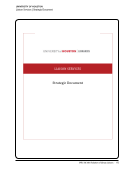SPEC Kit 349: Evolution of Library Liaisons · 167
CORNELL UNIVERSITY
Strategic Objective III.1 Formalize the Network of Library Liaisons… Final Report
2
II. Executive Summary
1. Environmental Scan of Liaison Activities at CUL
The team completed an environmental scan of the current liaison activities at CUL, which revealed that
they are robust and diverse and take into account the specificities of the schools, colleges, and
disciplines, the expertise of current liaisons, as well as staffing patterns at each library.
Generally speaking, liaison activities focus on two areas: research support services (including in-‐depth
reference support and instruction) and materials selection. Some liaisons focus on only one of those
areas, others on both in various proportions.
Assigning of liaisons varies by library—in some units, one liaison is assigned to multiple departments, in
others, all liaisons are assigned to individual faculty, in still others, one liaison is assigned to a
department. In rare cases, the liaison responsibilities are shared between a selector and a reference
librarian. In departments which reside in multiple schools, more than one liaison is assigned from
different libraries. Thus, the number of faculty per liaison varies greatly.
The full environmental scan of the current liaison activities, including conclusions and recommendation,
is included as Appendix 2.
2. Environmental Scan of Other Institutions
The team completed an environmental scan of liaison activities at other institutions, which revealed that
most liaison programs in polled institutions, with the exception of a few, are informal, fluid, with no
dedicated funding, no formal training, and no assessment tools. In all polled institutions, however,
significant efforts are underway to maintain strong relationships and share information with the
academic communities the libraries serve.
The full environmental scan of other institutions is included as Appendix 3.
3. General Expectations and Suggested Best Practices
Based on the conducted environmental scans and the feedback of the team’s LEG sponsors, who
identified three areas to focus liaison activities on: reference and instruction collection development,
and scholarly communication, the team compiled documents delineating the general practices (for
liaisons who do not work in the specific area) and suggested best practices (for liaisons who do work in
the respective specific areas), which are included as Appendix 4.
These documents were compiled and revised multiple times after the team gathered feedback from
liaisons and library administrators at the Reference and Outreach Forum, selectors’ teams (Humanities,
Social Sciences, Sciences, Area Team), PSEC, CDExec, individual liaisons, as well as faculty.
CORNELL UNIVERSITY
Strategic Objective III.1 Formalize the Network of Library Liaisons… Final Report
2
II. Executive Summary
1. Environmental Scan of Liaison Activities at CUL
The team completed an environmental scan of the current liaison activities at CUL, which revealed that
they are robust and diverse and take into account the specificities of the schools, colleges, and
disciplines, the expertise of current liaisons, as well as staffing patterns at each library.
Generally speaking, liaison activities focus on two areas: research support services (including in-‐depth
reference support and instruction) and materials selection. Some liaisons focus on only one of those
areas, others on both in various proportions.
Assigning of liaisons varies by library—in some units, one liaison is assigned to multiple departments, in
others, all liaisons are assigned to individual faculty, in still others, one liaison is assigned to a
department. In rare cases, the liaison responsibilities are shared between a selector and a reference
librarian. In departments which reside in multiple schools, more than one liaison is assigned from
different libraries. Thus, the number of faculty per liaison varies greatly.
The full environmental scan of the current liaison activities, including conclusions and recommendation,
is included as Appendix 2.
2. Environmental Scan of Other Institutions
The team completed an environmental scan of liaison activities at other institutions, which revealed that
most liaison programs in polled institutions, with the exception of a few, are informal, fluid, with no
dedicated funding, no formal training, and no assessment tools. In all polled institutions, however,
significant efforts are underway to maintain strong relationships and share information with the
academic communities the libraries serve.
The full environmental scan of other institutions is included as Appendix 3.
3. General Expectations and Suggested Best Practices
Based on the conducted environmental scans and the feedback of the team’s LEG sponsors, who
identified three areas to focus liaison activities on: reference and instruction collection development,
and scholarly communication, the team compiled documents delineating the general practices (for
liaisons who do not work in the specific area) and suggested best practices (for liaisons who do work in
the respective specific areas), which are included as Appendix 4.
These documents were compiled and revised multiple times after the team gathered feedback from
liaisons and library administrators at the Reference and Outreach Forum, selectors’ teams (Humanities,
Social Sciences, Sciences, Area Team), PSEC, CDExec, individual liaisons, as well as faculty.












































































































































































































